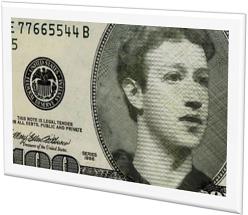 With all this talk about Facebook’s IPO, there’s been an incredible amount of attention in both the digital and financial worlds about this amazing company. So I won’t bore you with any financial predictions or even attempt to advise you about the wisdom of “getting in on the ground floor” of Facebook.
With all this talk about Facebook’s IPO, there’s been an incredible amount of attention in both the digital and financial worlds about this amazing company. So I won’t bore you with any financial predictions or even attempt to advise you about the wisdom of “getting in on the ground floor” of Facebook.
But the open book that accompanies the process of going public ought to raise questions for every business – or radio station – that has used a Facebook “Fan” or “Like” page. In the radio industry, this is rapidly becoming “everybody.”
In the digital media initiatives and strategy sessions that we are now regularly conducting for radio clients around the U.S., a part of that process centers on establishing a hierarchy of channels that programmers, sales managers, and others must address. What are the most important connection points in the digital tool box? How can we prioritize how we deploy station resources?
The job of running a radio station has become far more complex over the last 15 or so years. Back when I programmed, about the only thing you had to worry about was the “mother ship” – your AM or FM station, getting in trouble with the FCC, and two or four ARB books a year. Life was oh so simpler then.
The graphic below loosely illustrates the progression of channels that radio companies have had to contend with over time. Many broadcasters have simply just taken them on, often without thinking about their implications on staff, budget, and impact. Others have just skipped certain steps due to expense. But in any case, there is a lot more “digital real estate” to attend to – and it’s getting more complex every year.
This might be analogous to being a dog owner – not a difficult task in and of itself, but certainly one that requires time, energy, patience, love, and money. Most of us are very capable of raising a dog, just as we are running a successful radio station.
But imagine if every year or so, your kids came home with another pet. A cat one year. A guinea pig the next. And maybe as the years went by, you found yourself caring for a snake, a rabbit, a goat, and maybe even a pony (Facebook). And each of these pets requires a different level of care and feeding, not to mention the task of making them all get along together.
All of a sudden you’re running a complicated household.
And who’s taking care of the dog?
So it’s helpful using research, your own metrics, and other “intel” to prioritize the channels that matter most to your brand because you probably can’t do justice to them all.
And something that we also have to consider is the fact that these digital tools have very different characteristics.
For example, with some channels, you “own” the data and the inventory; with others, you are merely a “renter.”
You “own” your own air, your website, and your database.
You “rent” your Facebook fans and Twitter followers.
But does it matter? After all, many programmers and DJs will tell you that more of their listeners visit their Facebook page than their website. And the real-time response they get from the former is more instantly gratifying because the audience connection is dynamic.
But while Facebook is “the 800 pound gorilla” (or maybe the “850 million gorillas”) today, it could change its rules, its policies, and its model tomorrow. And that could impact the way its “Fan” pages are treated and monetized.
If you don’t think that’s possible, consider the ways that rules and regulations are always changing on Facebook, whether it’s about privacy or the installation of “Timeline” – whether you want it or not. Chances are good that no one from Facebook has consulted with you about these changes. Nor do I know anyone who has been a respondent in a Facebook survey. Facebook is governed by its own set of rules and goals. We’re all along for the ride.
Marketing Week reporter Lara O’Reilly points out that Facebook’s IPO could bring about changes in the company’s revenue and profit models. One of her theories is that while they have been free up to now, Facebook brand pages could become overnight profit centers. When you consider that Coca-Cola, Starbucks, and others have amassed tens of millions of fans, what would stop Facebook from beginning to monetize these pages? After all, they provide virtually free advertising and marketing to the corporations and brands that run them. When you consider that four million businesses have Facebook pages…well, you’ve got a pretty scalable business.
 A per-“like”-fee, for example, would change the game for thousands of brands that are not paying a dime to Facebook. At 10¢ per fan, for instance, Starbucks would have an annual fee of about $2.8 million for its nearly 28 million “likes.” KISW would pay more than $3,600 a year for its legions of fans. You can do the math on how much money this might generate for Facebook, and how some radio station brands would be faced with sudden and unforeseen charges.
A per-“like”-fee, for example, would change the game for thousands of brands that are not paying a dime to Facebook. At 10¢ per fan, for instance, Starbucks would have an annual fee of about $2.8 million for its nearly 28 million “likes.” KISW would pay more than $3,600 a year for its legions of fans. You can do the math on how much money this might generate for Facebook, and how some radio station brands would be faced with sudden and unforeseen charges.
You could make the case that both Starbucks and KISW can afford these fees. But that ignores the fact that all of this “free marketing” may not always come at no cost to brands and marketers.
And that’s why this issue is at the heart of the “rent/own” question. Because your database and your website are “digital real estate” that you own – not Mark Zuckerberg or anyone else. All those tens of thousands of listener email addresses that you’ve gathered and all those avails on your website are proprietary. They’re yours.
The Facebook IPO will be a game-changer in many ways. Expect to hear questions from more radio people as well as your Aunt Rose about its value and its implications. And at this point, they are hard to answer.
But when it comes to having your house in order, you know the score.
Ownership has its privileges.
- What To Do If Your Radio Station Goes Through A Midlife Crisis - April 25, 2025
- A 2020 Lesson?It Could All Be Gone In A Flash - April 24, 2025
- How AI Can Give Radio Personalities More…PERSONALITY - April 23, 2025





Leave a Reply